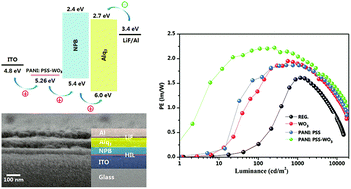当前位置:
X-MOL 学术
›
J. Mater. Chem. C
›
论文详情
Our official English website, www.x-mol.net, welcomes your
feedback! (Note: you will need to create a separate account there.)
Doped polyaniline-hybridized tungsten oxide nanocrystals as hole injection layers for efficient organic light-emitting diodes†‡
Journal of Materials Chemistry C ( IF 5.7 ) Pub Date : 2018-06-04 00:00:00 , DOI: 10.1039/c8tc01005f Wenjuan Zhu 1, 2, 3, 4, 5 , Xu-Lin Chen 1, 2, 3, 4, 5 , Jianfei Chang 1, 2, 3, 4, 5 , Rong-Min Yu 1, 2, 3, 4, 5 , Haoran Li 1, 2, 3, 4, 5 , Dong Liang 1, 2, 3, 4, 5 , Xiao-Yuan Wu 1, 2, 3, 4, 5 , Yuansheng Wang 1, 2, 3, 4, 5 , Can-Zhong Lu 1, 2, 3, 4, 5
Journal of Materials Chemistry C ( IF 5.7 ) Pub Date : 2018-06-04 00:00:00 , DOI: 10.1039/c8tc01005f Wenjuan Zhu 1, 2, 3, 4, 5 , Xu-Lin Chen 1, 2, 3, 4, 5 , Jianfei Chang 1, 2, 3, 4, 5 , Rong-Min Yu 1, 2, 3, 4, 5 , Haoran Li 1, 2, 3, 4, 5 , Dong Liang 1, 2, 3, 4, 5 , Xiao-Yuan Wu 1, 2, 3, 4, 5 , Yuansheng Wang 1, 2, 3, 4, 5 , Can-Zhong Lu 1, 2, 3, 4, 5
Affiliation

|
Solution-processed tungsten oxide nanocrystals (WO3 NCs) hybridized with a conductive polymer, polyaniline:poly(styrene sulfonate) (PANI:PSS), are introduced as a hole injection layer (HIL) in organic light-emitting diodes (OLEDs). These devices exhibited much higher current efficiency (CE) and power efficiency (PE) compared to regular devices without HILs and devices using pristine WO3 NCs as HILs. This enhanced device performance is mainly attributed to the facilitated hole injection due to the improvement in the energy level alignment at the interface between the ITO anode and the organic semiconductor layer. Besides, PANI:PSS can efficiently reduce surface defects and enhance the film-forming properties of WO3 NCs without affecting the device conductivity. These results suggest that PANI:PSS–WO3 could be a promising candidate for charge injection layers in optoelectronic devices.
中文翻译:

掺杂的聚苯胺杂化的氧化钨纳米晶体作为有效有机发光二极管的空穴注入层† ‡
将与导电聚合物,聚苯胺:聚(苯乙烯磺酸盐)(PANI:PSS)杂化的固溶处理氧化钨纳米晶体(WO 3 NC)作为空穴注入层(HIL)引入有机发光二极管(OLED)中。与没有HIL的常规设备和使用原始WO 3 NC作为HIL的设备相比,这些设备展现出更高的电流效率(CE)和功率效率(PE)。由于在ITO阳极和有机半导体层之间的界面处的能级对准的改善,这种增强的器件性能主要归因于空穴注入的便利。此外,PANI:PSS可以有效减少表面缺陷并增强WO 3的成膜性能。NC不影响器件电导率。这些结果表明,PANI:PSS–WO 3可能是光电子器件中电荷注入层的有前途的候选者。
更新日期:2018-06-04
中文翻译:

掺杂的聚苯胺杂化的氧化钨纳米晶体作为有效有机发光二极管的空穴注入层† ‡
将与导电聚合物,聚苯胺:聚(苯乙烯磺酸盐)(PANI:PSS)杂化的固溶处理氧化钨纳米晶体(WO 3 NC)作为空穴注入层(HIL)引入有机发光二极管(OLED)中。与没有HIL的常规设备和使用原始WO 3 NC作为HIL的设备相比,这些设备展现出更高的电流效率(CE)和功率效率(PE)。由于在ITO阳极和有机半导体层之间的界面处的能级对准的改善,这种增强的器件性能主要归因于空穴注入的便利。此外,PANI:PSS可以有效减少表面缺陷并增强WO 3的成膜性能。NC不影响器件电导率。这些结果表明,PANI:PSS–WO 3可能是光电子器件中电荷注入层的有前途的候选者。











































 京公网安备 11010802027423号
京公网安备 11010802027423号